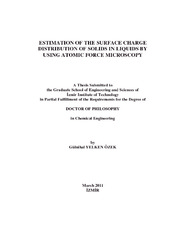Please use this identifier to cite or link to this item:
https://hdl.handle.net/11147/2893Full metadata record
| DC Field | Value | Language |
|---|---|---|
| dc.contributor.advisor | Polat, Mehmet | en |
| dc.contributor.author | Yelken Özek, Gülnihal | - |
| dc.date.accessioned | 2014-07-22T13:48:34Z | - |
| dc.date.available | 2014-07-22T13:48:34Z | - |
| dc.date.issued | 2011 | en |
| dc.description | Thesis (Doctoral)--Izmir Institute of Technology, Chemical Engineering, Izmir, 2011 | en |
| dc.description | Includes bibliographical references (leaves: 131-139) | en |
| dc.description | Text in English; Abstract: Turkish and English | en |
| dc.description | xxi, 152 leaves | en |
| dc.description.abstract | Colloidal systems are widely encountered in minerals, ceramics, environment, biology, pharmaceuticals and cosmetics industries. These systems consist of micronsized particulates dispersed in a solvent. Homogeneity, dispersibility, stability of colloidal systems determines the economy and success of the final product in these applications. Control and manipulation of these properties depend on detailed analysis of the interactions among the particles. Electrophoretic potential measurements or colloidal titration methods are widely employed to characterize the charging of colloidal systems. However these methods only yield average charging information, not the charge distribution on the surface. Atomic Force Microscope (AFM) allows topographic surface analysis at nanometer level resolutions. Though it is widely used to obtain derived information AFM directly measures the forces between the tip and the surface atoms. The objective of the present work is to assess the applicability of AFM to surface charge mapping, i.e., the detection of positive or negative charged regions on metal oxide surfaces. Hence, well defined tips were prepared and allowed to interact with well defined oxide surfaces under different pH conditions. The influence of solution ion concentration and pH on the forces measured was also investigated. These measured force-distance curves were analyzed using a new solution of the one dimensional Poisson-Boltzmann equation to isolate the electrical double layer force, hence the surface charge on each measurement point. The new solution in question provides analytical expressions for all charging conditions which are amenable to such analysis.Repetitive force measurements on a predefined grid on the solid surface ultimately yield the charge distribution of the surface. Such an analysis procedure is new and advances the charge measurements on solids in solution to a new level. | en |
| dc.language.iso | en | en_US |
| dc.publisher | Izmir Institute of Technology | en |
| dc.rights | info:eu-repo/semantics/openAccess | en_US |
| dc.subject.lcsh | Surface chemistry | en |
| dc.subject.lcsh | Solids--Surfaces | en |
| dc.subject.lcsh | Atomic force microscopy | en |
| dc.subject.lcsh | Liquids | en |
| dc.title | Estimation of the surface charge distribution of solids in liquids by using atomic force microscopy | en_US |
| dc.type | Doctoral Thesis | en_US |
| dc.department | Thesis (Doctoral)--İzmir Institute of Technology, Chemical Engineering | en_US |
| dc.relation.publicationcategory | Tez | en_US |
| item.languageiso639-1 | en | - |
| item.fulltext | With Fulltext | - |
| item.openairecristype | http://purl.org/coar/resource_type/c_18cf | - |
| item.openairetype | Doctoral Thesis | - |
| item.grantfulltext | open | - |
| item.cerifentitytype | Publications | - |
| crisitem.author.dept | 03.02. Department of Chemical Engineering | - |
| Appears in Collections: | Phd Degree / Doktora Sürdürülebilir Yeşil Kampüs Koleksiyonu / Sustainable Green Campus Collection | |
Files in This Item:
| File | Description | Size | Format | |
|---|---|---|---|---|
| T000923.pdf | DoctoralThesis | 5.45 MB | Adobe PDF |  View/Open |
CORE Recommender
Page view(s)
130
checked on Jul 22, 2024
Download(s)
80
checked on Jul 22, 2024
Google ScholarTM
Check
Items in GCRIS Repository are protected by copyright, with all rights reserved, unless otherwise indicated.